|
|
 |
|
 |
|
Velid Đekić ALPHABET AS HERITAGE Glagolitic letters in the soul  If
legends can be trusted - and they do often contain more than a grain of
truth - many nations across the world acquired their alphabetical system
and the skill of writing as a gift from some divinity. But although they
too had many legends, the Croats decided to be different. Instead of
giving credit to a divinity, they noted the name of the man of flesh and
blood who created their alphabet that they would use to immortalise
spoken words. It happened in the 9th century AD, probably not imitating
any alphabets that were known at that time, like the Greek, Latin or
Hebrew. If
legends can be trusted - and they do often contain more than a grain of
truth - many nations across the world acquired their alphabetical system
and the skill of writing as a gift from some divinity. But although they
too had many legends, the Croats decided to be different. Instead of
giving credit to a divinity, they noted the name of the man of flesh and
blood who created their alphabet that they would use to immortalise
spoken words. It happened in the 9th century AD, probably not imitating
any alphabets that were known at that time, like the Greek, Latin or
Hebrew.The origin of the Glagolitic alphabet (Glagolitsa, Glagolica) and its adoption by the Croats is mostly connected to the missionary work of Cyril (Constantine the Philosopher) and his brother Methodius among the Slavs. Two governors also played their roles in this event, one by the name of Michael, the other by the name of Rastislav. It is said that when Prince Rastislav requested a mission to be sent to his province Moravia (today a part of the Czech Republic) in order to promote Christianity through books that would be written in letters reflecting the vernacular language, the Byzantine Emperor Michael sent two monks in 863: Cyril (Constantine), born 826 or 827 in Thessaloniki, philosophy teacher at the Royal High School in Constantinople, known as The Philosopher due to his erudition, and his older brother Methodius (born between 815 and 820, also in Thessaloniki). Croats only became acquainted with the educational work of these two brothers after the death of Cyril (in 869) and Methodius (in 885), thanks to their students who spread the Glagolitic alphabet and the liturgy in the Old Slavic language among the Croats, primarily in the Adriatic part of the land. According to one of the theories, Cyril created the Glagolitic alphabet within two years, in the period between 861 and 863. He used theological symbolism and the geometrical logic of the circle, triangle and square - the three basic geometrical figures, and at the same time the three main symbols by which many cultures, religions and teachings in Constantine’s time explained the integrity of the universe and the manifestation of the world. The circle symbolises the sun, the integrity and perfection of the divinity that gives life. The triangle is the symbol of the large triad that unites heaven and earth with man as the product of their union (the Holy Trinity). The square is the symbol of the Earth, the four seasons, the four elements (water, fire, air and earth). Cyril decided to start this new Glagolitic alphabet with the letter for the sound A. The three variants of writing Glagolitic letters that are known today – triangular, round and square – have, however, nothing to do with the symbolism represented by the triangle, circle and square. The letters that initially used to be triangularly shaped during Cyril's time, later became round - a change that was conditioned by the characteristics of the human hand and of the writing tools of the time (reed or goose-feather quills). In the next phase, letters became square (angular) as a result of the wish to give text a neater, more solemn appearance. This could also be a result of the Glagolitic scribes following the styles of the Latin letters used in Europe’s scriptoriums. The italic, handwritten type of the Glagolitic alphabet was an informal variant resulting from the quick handwriting of everyday practice. The Glagolitic alphabet spread across three main areas: Czech and Moravia, Bulgaria and Macedonia, and Croatia. Is the fact that in Croatia, the Glagolitic alphabet took root most strongly right here on Kvarner and in neighbouring regions just a coincidence, or was it a result of historic circumstances? That question, as well as why the oldest Croatian Glagolitic monuments were found on the Kvarner islands of Krk and Cres, remains unanswered. Glagolitsa was indeed widespread on Kvarner: on the island of Cres (Porozina, Valun, Beli, Osor), on the island of Krk (Omišalj, Klimno, Dobrinj, Dobrinsko polje, Sv. Vid, Dubašnica, Glavotok, Poljica, Krk, Kras, Gabonjin, Vrbnik, Punat, Jurandvor, Baška), on the island of Lošinj (Ćunski, Sv. Jakov), on the island of Rab (Rab), on the island of Unije; also in Rijeka, Grobnik, Cernik, Klana, Lovran, Brseč, Mošćenice, Veprinac, Rukavac, Volosko, Kastav, Bakar, Drivenik, Rudenice, Belgrad, Grižane, Podskoča, Bribir, Novi Vinodolski. The work of the brothers Cyril and Methodius continued to live on Kvarner where it achieved its most vital form. What is more, Glagolitsa became the Croatian national alphabet. It had an exceptional place in the history of Croatian culture; we know this from the fact that some of the first printed Croatian documents were printed in Glagolitic letters, like the first printed Croatian book (Misal po zakonu rimskoga dvora, 22nd February 1483), then the first Croatian primer (1527), the first printed Croatian verses (in Misal by Duke Novak, 1368). Despite the fact that it was created primarily for religious purposes, the Glagolitic alphabet did not remain restricted to it. Numerous Glagolitic documents concerning the legal system of individual regions attest to it, like the Statute of the Town of Krk (1388), the Statute of Trsat (1460), the Statute of the Town of Vrbnik (1470), the Statute of the Municipality of Veprinac (1507), the Statute of the Town of Kastav (around 1590), the Statute of the Town of Mošćenice (1673), etc. The Glagolitic alphabet flourished in Croatia in the 14th and 15th centuries, thanks to the clergy that had all the necessary material at their disposal. Texts were primarily transcribed in scriptoriums, but some of them were printed. The history of Croatian Glagolitic printing is over four centuries old, dating from 1483 until 1905. In that period some fifty books were printed, including five incunabula (books printed before 1500) that we know of today. Two of these were made by Blaž Baromić from Vrbnik on the island of Krk: the Croatian Breviary (Brevijar hrvacki, 1493) and the Missal of Senj (Senjski misal, 1494). Who were the scholars and keepers of this part of Croatia’s cultural heritage? One of the first among them was Ivan Kukuljević Sakcinski who discovered the Baška Tablet (Bašćanska ploča) in 1851 and collected 27 Glagolitic books (including the oldest one, from 1321) and more than 20 documents during his three-day visit to the island of Krk. His work was continued by many followers, among them the bishop of Krk Antun Mahnić who founded the Old Slavic Academy and Printing House at the beginning of the 20th century; then Svetozar Ritig, Vjekoslav Štefanić and Josip Hamm who founded the Old Slavic Institute in 1948. Particularly important too was the work of Branko Fučić (1920 – 1999) from Dubašnica on the island of Krk. Fučić discovered more than half of all the Glagolitic records that are known of today, mainly on Kvarner, and some 60 medieval frescoes, mostly in neighbouring Istria. The circle of discoveries was recently closed in a symbolic way, when in December 2004 a boy by the name of Antonio Torre discovered the oldest Glagolitic inscription in Rijeka in the area of Sv. Križ. The clay tablet that he found, with a few letters that were probably engraved in the 13th century, is now known as the Fragment from Sveti Križ (Svetokriški ulomak). The Glagolitic alphabet was in use until the 19th century. But this does not mean that this alphabet belongs only to the past and to the researchers of cultural heritage. It will remain alive as long as it is being written by the hands of new generations. And it is being written. One example of this is the School of Glagolitsa in Kornić, aimed at children interested in learning this ancient alphabet during their summer holidays. At the school, the most skilled of them can practise transcribing old documents and take part in the Glagolitic graffiti workshop. Their schooling ends with an excursion along the Glagolitic paths on Kvarner. Although 13-14 percent of the 1,200 inscriptions on stone or on the walls in Croatia have disappeared or been destroyed over the last hundred years, Glagolitsa will not perish. As its name says, it continues to speak (glagoljati comes from the word glagoliti, which means “to speak”). Recently the Glagolitic computer font was created, thus making it possible to write in these ancient letters using the latest technology and opening a door to the new, digital millennium for this alphabet.  Today
old Glagolitic manuscripts are kept in most renowned cultural institutes
worldwide - for the Glagolitic alphabet has a high cultural value as an
ancient mediator between the East and the West. Besides in Croatia,
Glagolitic documents are kept in Vienna, the Vatican, Cambridge, Oxford,
New York, Washington, Berlin, Weimar, Wertheim, Copenhagen, Innsbruck,
Odessa, Kiev, Moscow, St. Petersburg, London, Paris, Tours, Reims, Rome,
Trento, Padua, Florence, Trieste, Sienna, Uppsala, Budapest, Istanbul,
Prague, Krakow, Wroclav, Hlohovec, Porto, Ljubljana… Today
old Glagolitic manuscripts are kept in most renowned cultural institutes
worldwide - for the Glagolitic alphabet has a high cultural value as an
ancient mediator between the East and the West. Besides in Croatia,
Glagolitic documents are kept in Vienna, the Vatican, Cambridge, Oxford,
New York, Washington, Berlin, Weimar, Wertheim, Copenhagen, Innsbruck,
Odessa, Kiev, Moscow, St. Petersburg, London, Paris, Tours, Reims, Rome,
Trento, Padua, Florence, Trieste, Sienna, Uppsala, Budapest, Istanbul,
Prague, Krakow, Wroclav, Hlohovec, Porto, Ljubljana…Square Glagolitsa is a younger variant of the Glagolitic alphabet that emerged from round Glagolitsa in the 11th century in Croatia. It is interesting to mention that soon afterwards, people outside Croatia ceased using the Glagolitic alphabet. Although it was initially created to be the alphabet of all Slavs, Glagolitsa remained preserved only in the Croatian part of the large Slavic area, since the 12th century until today. The beginnings of square Glagolitsa can be seen on the famous Baška Tablet. The parallel processes of transforming round characters into square ones - which also happened in the 12th century - and the fact that the Glagolitic alphabet became limited to Croatian territory were the reasons to proclaim (square) Glagolitsa the Croatian national alphabet. The term Croatian alphabet was first mentioned in 1460 in a breviary by Fr. Mavro, a priest from Vrbnik on the island of Krk. This was also encouraged by the fact that the pope allowed Croatian clergy to use the Glagolitic alphabet. Pope Innocent IV allowed the Benedictines in Senj to use the Glagolitic mass (mass in the vernacular language) in 1248, and the Benedictines in Omišalj in 1252. Each letter has a name, knew the authors of the old Glagolitic records. Following this principle, each Glagolitic letter has its own “personality”, so A became az, B buki, V vidi, G glagole, D dobro, E jest, Ž živite, and so on. The names of the first ten letters, when written in the defined alphabetical order, make a meaningful sentence: “Az buki vidi glagole dobro jest živite zelo zemla….”, meaning, in free translation and adapted to the modern language, “Me, who knows the letters, say that it is good to live on Earth…”. Each letter has a numeric value. This rule has been put into practice by following the defined alphabetical order of the Glagolitic letters. Each letter was given a numeric value according to the rule that the first letter is also the first number in the row. Thus, the letter A became 1, B became 2, etc. (V = 3, G = 4, D = 5, E = 6, Ž = 7…). The first ten letters of the Glagolitic alphabet were the symbols for the first ten numbers. The next ten letters were the symbols for the tens (from I meaning 20, to R meaning 100). The next nine letters marked the hundreds (from S meaning 200 to Č meaning 1000). If a letter in a sentence was to be read as a number, the author of the text indicated as much with a special hyphen (title) above the letter, or with a dot before and after the letter. The Island of Krk is known as the cradle of the Glagolitic alphabet due to the fact that the alphabet took deep root there and stood the course of time. We know that from the impressive number of Glagolitic documents that were created and preserved on the island. Of around 700 Croatian Glagolitic manuscripts on parchment and paper, 469 originate from the island of Krk, and 255 are still kept there today. Since the Glagolitic writing was encouraged by the clergy - which was so numerous that in the 17th century there was a Glagolitic priest in nearly every family on the island - these data also attest to the strong influence this alphabet had on the island. For illustration, in the areas of the diocese of Krk, which encompasses the islands of Krk, Rab, Cres, Lošinj and a part of the island of Pag, there are 303 preserved printed Glagolitic missals and 87 breviaries. This is without taking into account whatever manuscripts disappeared over the course of time. The works of Vid Omišljanin (14th century) and deacon Luka from Vrbnik (15th century) lead us to conclude that a Glagolitic scriptorium probably existed on the island. 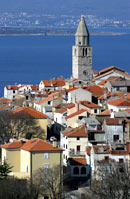 Vrbnik
was the most important centre of Glagolitic writing on the island of Krk
and Glagolitic writing in general. Of the 469 manuscripts on parchment
and paper from the island that are known of today, 105 originated from
Vrbnik. To this number one should add all the documents that probably
disappeared in the course of time. Particularly important are the first,
second, third and fourth Vrbnik Breviaries (13th and 14th centuries),
two Vrbnik missals (1456 and 1462), and the Vrbnik Statute (16th
century). Of some thirty Glagolitic collections of church texts,
breviaries, that are preserved in Croatia, the oldest is the Vrbnik
Breviary (13th/14th century). It consists of 259 sheets of parchment and
is kept in its place of origin. Everyday life in this insular place was
regulated by rules laid down in the Vrbik law from 1388. We also learn
about the legal system in Vrbnik from a notarial book containing a
register of the names of thieves to be hanged after their third theft. Vrbnik
was the most important centre of Glagolitic writing on the island of Krk
and Glagolitic writing in general. Of the 469 manuscripts on parchment
and paper from the island that are known of today, 105 originated from
Vrbnik. To this number one should add all the documents that probably
disappeared in the course of time. Particularly important are the first,
second, third and fourth Vrbnik Breviaries (13th and 14th centuries),
two Vrbnik missals (1456 and 1462), and the Vrbnik Statute (16th
century). Of some thirty Glagolitic collections of church texts,
breviaries, that are preserved in Croatia, the oldest is the Vrbnik
Breviary (13th/14th century). It consists of 259 sheets of parchment and
is kept in its place of origin. Everyday life in this insular place was
regulated by rules laid down in the Vrbik law from 1388. We also learn
about the legal system in Vrbnik from a notarial book containing a
register of the names of thieves to be hanged after their third theft.Glagolitic stone inscriptions were discovered only in the Croatian ethnic area. Moreover, the Croats engraved in stone their first texts that were not of a religious or royal nature. Among these are some of the most important monuments of Croatian Glagolitic writing, such as the famous Baška Tablet (Bašćanska ploča), Krk inscription (Krčki natpis), and the Valun Tablet (Valunska ploča). Inscriptions on blocks of stone or on wall plaster can hardly be moved, therefore they provide evidence that the Glagolitic alphabet was widely used and deeply rooted, and that Croatian people have been present for centuries in this region. The Valun Tablet (Valunska ploča), one of the oldest Glagolitic monuments, dates from the 11th century and was found in Valun on the island of Cres. It was probably a tombstone of a local family. It is irregular in shape and contains two short texts of identical content, written in two different types of letters (Glagolitic and Latin) and in two languages (Croatian and Latin). The table, inscribed with round Glagolitic letters, contains old Croatian names for three family generations: grandmother Tjeha, son Bratohna and grandson Juna. The bilingual quality of the Valun Tablet confirms that on the island there lived older inhabitants who spoke Roman (which developed from Latin) and newer settlers who spoke Croatian. This tablet, which also contains some elements of the oldest, triangular Glagolitic letters, is exhibited in the local parish church. The Krk Inscription (Krčki natpis) is a fragment of a large stone tablet with engraved letters from the 11th century, which places it among the oldest Glagolitic monuments that are known today. The fragment got its name from the place where it was found, that is, today’s town of Krk. The inscription records the construction of an unknown building by Glagolitic Benedictines, their abbot, and - this is maybe more important - three old Croatian names: Dobroslav, Radonja and Rugota. It is located on a wall of the staircase in the canonical house in Krk. 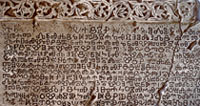 The
Baška Tablet (Bašćanska ploča), probably from 1105, has righteously
been known as the “precious stone of the Croatian language”. It was
found on 15th September 1851 on the island of Krk, in the small church
of St. Lucy (crkvica sv. Lucije) in Jurandvor near Baška. The stone
tablet is 198 cm long, 99 cm high and 8 cm thick. For the first 300
years, it stood in a vertical position, but since 1498 it has lain flat
on the church floor as a gravestone. Local inhabitants would step on it,
thus rubbing the engraved letters away. Despite that, today we still
have almost the complete text from the tablet. It records in a solemn
tone how two Benedictine abbots erected the church of St. Lucy on a
piece of ground given to them by the Croatian king Zvonimir. The record
consists of 13 lines of Glagolitic letters. Apart from indicating that
the area of Kvarner was by then already a part of Croatia, its
particular importance comes from the fact that it is also the first
document in which the name of a Croatian ruler is mentioned in the
Croatian language. Therefore, this tablet is known as “the birth
certificate of the Croats”. The Baška Tablet is one of the crucial
Croatian cultural and historical artefacts in general. The original is
kept in the Croatian Academy of Science and Arts (Hrvatska akademija
znanosti i umjetnosti) in Zagreb. The
Baška Tablet (Bašćanska ploča), probably from 1105, has righteously
been known as the “precious stone of the Croatian language”. It was
found on 15th September 1851 on the island of Krk, in the small church
of St. Lucy (crkvica sv. Lucije) in Jurandvor near Baška. The stone
tablet is 198 cm long, 99 cm high and 8 cm thick. For the first 300
years, it stood in a vertical position, but since 1498 it has lain flat
on the church floor as a gravestone. Local inhabitants would step on it,
thus rubbing the engraved letters away. Despite that, today we still
have almost the complete text from the tablet. It records in a solemn
tone how two Benedictine abbots erected the church of St. Lucy on a
piece of ground given to them by the Croatian king Zvonimir. The record
consists of 13 lines of Glagolitic letters. Apart from indicating that
the area of Kvarner was by then already a part of Croatia, its
particular importance comes from the fact that it is also the first
document in which the name of a Croatian ruler is mentioned in the
Croatian language. Therefore, this tablet is known as “the birth
certificate of the Croats”. The Baška Tablet is one of the crucial
Croatian cultural and historical artefacts in general. The original is
kept in the Croatian Academy of Science and Arts (Hrvatska akademija
znanosti i umjetnosti) in Zagreb. 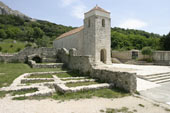 Fragments
from Baška or Jurandvor (Bašćanski ili Jurandvorski ulomci) were
found at the same place as the Baška Tablet, in the small church of St.
Lucy in Jurandvor on the island of Krk. These are three stone fragments
with Glagolitic inscriptions from the same period, that is, from the
turn of the 11th and 12th centuries. Since the Baška Tablet was used in
the church as a left-hand-side vertical partition (septum) between the
sanctuary and the visitors’ area, the Fragments from Jurandvor are
probably the remnants of the destroyed right-hand-side partition on
which the text of the Baška Tablet continued. This means that these
fragments are actually – the second Baška Tablet. Two of them are kept
in the History Museum in Zagreb, and the third one disappeared in 1879.
Preserved is only a copy of the original fragment that was made in 1864,
on which a part of a Croatian name is engraved. Due to their particular
importance to Croatian cultural history, and also their puzzling
contents and disappearance, the Fragments from Jurandvor never cease to
stimulate the curiosity of the public. Fragments
from Baška or Jurandvor (Bašćanski ili Jurandvorski ulomci) were
found at the same place as the Baška Tablet, in the small church of St.
Lucy in Jurandvor on the island of Krk. These are three stone fragments
with Glagolitic inscriptions from the same period, that is, from the
turn of the 11th and 12th centuries. Since the Baška Tablet was used in
the church as a left-hand-side vertical partition (septum) between the
sanctuary and the visitors’ area, the Fragments from Jurandvor are
probably the remnants of the destroyed right-hand-side partition on
which the text of the Baška Tablet continued. This means that these
fragments are actually – the second Baška Tablet. Two of them are kept
in the History Museum in Zagreb, and the third one disappeared in 1879.
Preserved is only a copy of the original fragment that was made in 1864,
on which a part of a Croatian name is engraved. Due to their particular
importance to Croatian cultural history, and also their puzzling
contents and disappearance, the Fragments from Jurandvor never cease to
stimulate the curiosity of the public.The Vinodol Law (Vinodolski zakonik) is the oldest legal text in the Croatian language, and the second oldest Slavic law, therefore one of the most important legal documents of medieval European law. It was written in 1288 in the presence of Duke Leonardo Frankopan as the result of an agreement between nine municipalities in the Vinodol region. The representatives of Bakar, Bribir, Drivenik, Grižane, Grobnik, Hreljin, Ledenice, Novi Vinodolski and Trsat gathered together to write down the laws passed on to them by their ancestors. It is about the common law. A preserved transcript from the 16th century was written in italic Glagolitic letters and has 17 pages with 75 articles regulating, among other things, the extent of the Duke’s powers and his rights on punishment. Criminal proceedings did not include torture, which was unique for Europe at that time, and paid much attention to the moral protection of women. To mark the occasion of the 700th anniversary of the Law, a well was built on the main square of Novi Vinodolski. 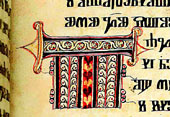 Vid
Omišljanin’s Breviary is a collection of Biblical liturgical texts
transcribed in 1396 by Vid from Omišalj on the island of Krk for the
parish church in Roč in Istria, possibly in the scriptorium in Omišalj.
Vid illustrated his handwriting with numerous initials. The Breviary
weighs 10 kg and is written on a parchment made from 117 sheepskins.
Today it is kept in the Austrian National Library in Vienna. Vid
Omišljanin’s Breviary is a collection of Biblical liturgical texts
transcribed in 1396 by Vid from Omišalj on the island of Krk for the
parish church in Roč in Istria, possibly in the scriptorium in Omišalj.
Vid illustrated his handwriting with numerous initials. The Breviary
weighs 10 kg and is written on a parchment made from 117 sheepskins.
Today it is kept in the Austrian National Library in Vienna.The Record of Father Martinac from the second Breviary from Novalja shows that Glagolitic priests used to add records of actual public events to the biblical texts. This record was made after the tragic Battle of Krbava (1493), in which most prominent Croatian nobles died fighting the Turks. From his native region of Krbava, Martinac came to the walled town of Grobnik near Rijeka where he organised a scriptorium with five writers. The Breviary was written for the Paulist monastery near Novi Vinodolski and was completed in 1495. The book has 500 parchment sheets, weighs 20 kg and is packed with beautiful initials. On the 267th sheet of the book, Martinac describes the tragedy in deeply moving words, giving account of burned houses, demolished churches, numerous refugees, old people, widows and children who lost their homes, imprisoned fighters sold into slavery, and the murder of the Croatian duke (knez) and governor (ban). Records like this one represent precious historical sources about crucial events for the survival of the Croatian people. Some of the Glagolitic priests took an active part in defending the Croatian territory. Blaž Baromić, the first known Croatian printer, was born in Vrbnik on the island of Krk around 1440. After becoming canon in the nearby town of Senj, Baromić opened a printing works that probably operated between 1494 and 1508. The owner of the works was archdeacon Silvestar Bedričić. Baromić put into practice the experience gained during his previous work in Venice where he printed the Croatian breviary (Brevijar hrvacki) in 1493. In Senj he printed at least seven titles. The first was the Missal according to the law of the Roman court (Misal po zakonu rimskoga dvora), also known as the Missal of Senj (Senjski misal) in 1494. That was the second edition of the first printed Croatian book - the first edition of the same missal was printed in 1483 at an unknown printing works. Other titles included Spovid općena (1496), the first book printed in Glagolitsa in the Čakavian dialect of the Croatian language, then the parish handbook Naručnik plebanušev (1507), Mirakuli slavne dive Marije (1507/1508), Tranzit sv. Jerolima (1508), Korizmenjak (1508) and Obrednik (1508). The appearance of these books shows that Baromić’s printing skill could be compared to the European standards of the period. Baromić’s publications are kept in Košljun, Vrbnik, Cres, Zagreb, Ljubljana, St. Petersburg, Vienna, London and Budapest. 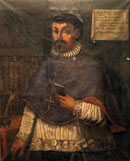 Šimun Kožičić Benja
(ca. 1456 – 1536), born to a patrician family from Zadar, and from 1509
bishop of Modruš, escaped to Novi Vinodolski after the Turkish invasion
in 1527. Two years later he came to Rijeka where he advocated printing
in the vernacular language and started a printing works in October 1530
after procuring woodcuts, initials, two types of Glagolitic letters and
other printing material from Venice. With the help of two hired
printers, štampadur Dominik and Bartolomej, he published two books in
the same year: Psaltir and a prayer book Oficij rimski. In the following
spring, Kožičić printed four more books: Misal hrvacki (his most
extensive printing work, 28th April 1531), a book of rites Knjižice
krsta (2nd May 1531), a handbook about the Roman popes and emperors
Knjižice od žitija rimskih arhijereov i cesarov (25th May 1531, the
first history book printed in the Croatian language), and Od bitija
redovničkoga knjižice (27th May 1531). After closing the printing works,
Benja left Rijeka. He was buried in 1536 on the island of Ugljan. Some
rare copies of his printing craftsmanship are still preserved in Zagreb,
St. Petersburg and Weimar. Šimun Kožičić Benja
(ca. 1456 – 1536), born to a patrician family from Zadar, and from 1509
bishop of Modruš, escaped to Novi Vinodolski after the Turkish invasion
in 1527. Two years later he came to Rijeka where he advocated printing
in the vernacular language and started a printing works in October 1530
after procuring woodcuts, initials, two types of Glagolitic letters and
other printing material from Venice. With the help of two hired
printers, štampadur Dominik and Bartolomej, he published two books in
the same year: Psaltir and a prayer book Oficij rimski. In the following
spring, Kožičić printed four more books: Misal hrvacki (his most
extensive printing work, 28th April 1531), a book of rites Knjižice
krsta (2nd May 1531), a handbook about the Roman popes and emperors
Knjižice od žitija rimskih arhijereov i cesarov (25th May 1531, the
first history book printed in the Croatian language), and Od bitija
redovničkoga knjižice (27th May 1531). After closing the printing works,
Benja left Rijeka. He was buried in 1536 on the island of Ugljan. Some
rare copies of his printing craftsmanship are still preserved in Zagreb,
St. Petersburg and Weimar.The Monastery on Košljun, a small island in the middle of the cove of Puntarska draga on the island of Krk, hosts numerous valuable Glagolitic books. At first it was one of the Benedictine communities on the island, in the period when there were more Benedictine monasteries on Krk than on any other Adriatic island. The Benedictines consistently use Latin language in their liturgy. But the Benedictines from Senj and Krk were the first of the Catholic monks to get papal approval for saying mass in the Old Slavic or Old Croatian language and to use the Glagolitic alphabet, which was a kind of worldwide exception. They stayed on Košljun until 1447 when the monastery went to the Franciscans who continued to use Glagolitsa. The Košljun library, the oldest and most representative library on the island, attests to it: it contains some one hundred incunabula, the oldest among them from the year 1471, fragments of the Croatian First Edition (Prvotisak), the Glagolitic missal by Pavao Modrušanin from the 16th century, and numerous other valuable Glagolitic texts. 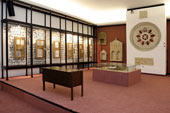 The University Library in Rijeka has hosted since 1968 a
permanent exhibition dedicated to the Glagolitic alphabet with 127
exhibits, casts of Glagolitic stone monuments from Kvarner and Istria,
codices, Glagolitic works of local stonemasons, Glagolitic literary
texts, legal texts, records from guilds and feudal manorial estates,
inscriptions on medieval frescoes, printed Glagolitic books in the
Croatian language, etc. The curators of the exhibition are the academic
Branko Fučić, Vanda Ekl, Ph.D., and Igor Emili, BSc (Archaeology).
Copies of frescoes were created by the academic painter Eugen Kokot. The
University Library not only keeps copies of the Glagolitic documents,
but also some of the originals, such as numerous old books that were
bound in parchment coming from even older Glagolitic books. This part of
the library’s collection has yet to be properly researched. The University Library in Rijeka has hosted since 1968 a
permanent exhibition dedicated to the Glagolitic alphabet with 127
exhibits, casts of Glagolitic stone monuments from Kvarner and Istria,
codices, Glagolitic works of local stonemasons, Glagolitic literary
texts, legal texts, records from guilds and feudal manorial estates,
inscriptions on medieval frescoes, printed Glagolitic books in the
Croatian language, etc. The curators of the exhibition are the academic
Branko Fučić, Vanda Ekl, Ph.D., and Igor Emili, BSc (Archaeology).
Copies of frescoes were created by the academic painter Eugen Kokot. The
University Library not only keeps copies of the Glagolitic documents,
but also some of the originals, such as numerous old books that were
bound in parchment coming from even older Glagolitic books. This part of
the library’s collection has yet to be properly researched.Valun and Porat Glagolitic Lapidarium are collections of stone monuments consisting of casts of the most important Glagolitic texts from the wider area of Kvarner. The collection in Valun on the island of Cres was created in 1987 and is located in front of a tavern called Juna, after the grandson’s name engraved on the Valun Tablet. Casts of 14 old Glagolitic texts are built into the walls of this tavern, just above the tables. The collection in the monastery of St. Mary Magdalene in Porto was created in 1990 and contains the same 14 casts, all of them created by Branko and Drago Fučić. |
|
|
|
|||||
 THE KVARNER COUNTY TOURISM OFFICE 51410 Opatija, Nikole Tesle 2, tel: +385/51/272-988, fax: +385/51/272-909 http://www.kvarner.hr, e-mail:kvarner@kvarner.hr |
|||||